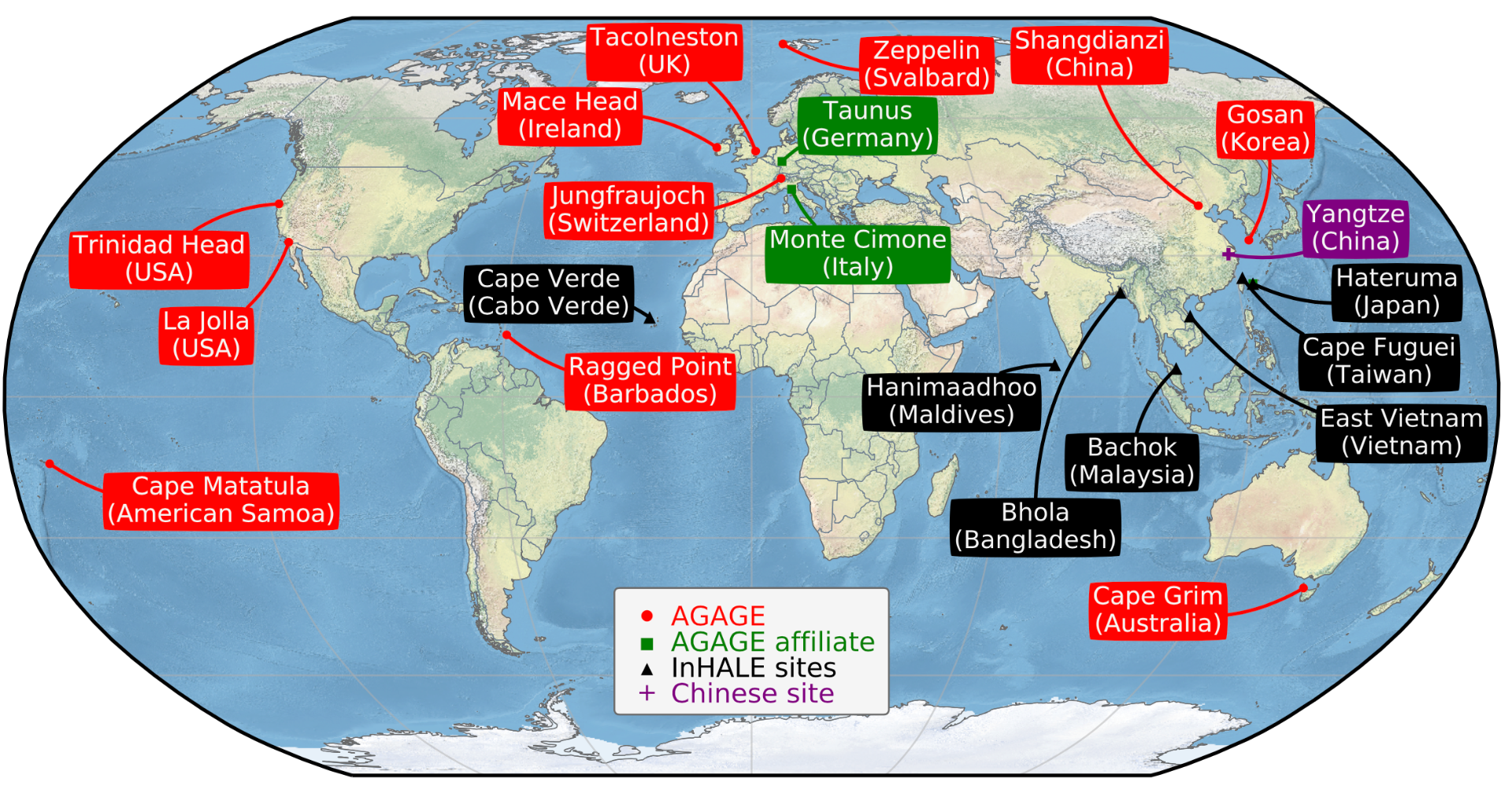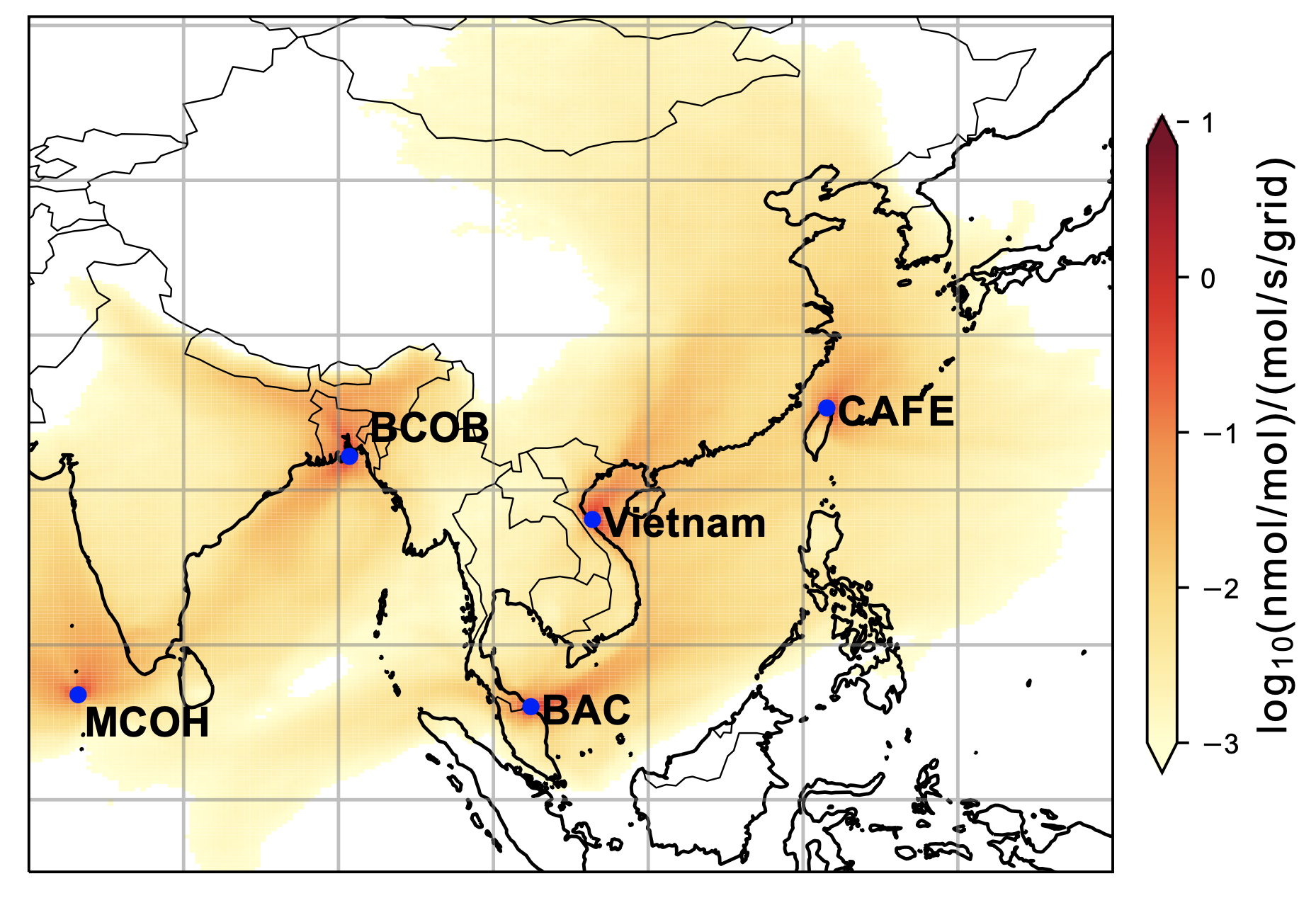WP1
Lead – Kieran Stanley, University of Bristol
The limitations of the current, sparse global network, starkly demonstrated through our inability to fully account for the recent global CFC-11 emission rise (Rigby et al., 2019), are being actively scrutinised, and proposals for expansion explored (e.g., Weiss, 2021; UNEP, 2021). InHALE will provide leadership in this area by implementing new measurements across South and East Asia by upgrading current sites in their capacity to measure a full suite of halocarbons and implementing measurements of the newest generation of halocarbon compounds that are emerging in the atmosphere.

WP 1.1: Expanded coverage of observations
South Asia is not well observed by existing measurement networks (see map above) and previous efforts to quantify halocarbon emissions from India have relied on sparse aircraft campaigns (e.g., Say et al., 2019).
Flask Measurement Sites will target outflow from industrialised regions using air trajectories to help time flask samples.
- Hanimaadhoo Island, Maldives (MCOH), will intercept polluted air outflow from South Asia, largely targeting southern India and South Asian background.
- Bhola Island, Bangladesh (BCOB), due to the sensitivity of BCOB to South Asian air masses.
- Flasks will be collected during times of outflow from industrialised regions to each site (using forecast trajectories to optimise sampling)
- Cape Fuguei (CAFE), Taiwan and Bachok (BAC), Malaysia
- A New site on the north-east coast of Vietnam will capture the outflow from western and southern China, an important industrial region not covered by existing networks and likely to be a significant halocarbon source region.
High Frequency Measurements
- Hateruma (HAT), Air masses from eastern and southern China are often observed during the northern hemispheric winter months and have been used in several regional inverse studies (e.g., Rigby et al., 2019). In a collaboration between York and the National Institute for Environmental Studies (NIES) Japan, instrumentation at HAT will be upgraded to measure a wider suite of halocarbons than are currently measured at the site, including HFOs and 1,2-dichloroethane.
- Cape Verde Atmospheric Observatory (CVAO) An upgrade of instrumentation at this site, run by the University of York, will enable the first high-frequency measurements of many important halocarbons in the eastern Atlantic and provide valuable new data to constrain global and regional (West Africa) models.

WP 1.2: Detection of new halocarbon species (Bristol)
Through a collaboration with Empa, Switzerland, mass spectra and relative retention times for compounds that have been newly detected in the atmosphere will be shared and used on the Bristol, Tacolneston and Mace Head Medusa GC-MS systems. Initially adding measurements of 1,2-dichloroethane and HFO-1336mzzZ. Calibration scales developed by Empa will be propagated to the InHALE measurement groups through tank exchange (WP1.3). We will work closely with Empa and AGAGE colleagues to identify, and share instrumental data on, further emerging compounds throughout the project.
WP 1.3: Measurement data harmonisation (Bristol)
Data will be harmonised from InHALE groups (currently on a mix of AGAGE, NOAA and UEA scales) through a tank exchange programme. Two cylinders, spiked with HFOs (HFO-1234yf, – 1234ze(E), -1336mzz(Z) and HCFO-1233zd(E) plus any extra compounds from WP 1.2) to ensure detectability, will be filled at Mace Head and circulated in the tank exchange.
Rigby et al., 2019, Nat., 569, 546-550;
UNEP, 2021, UNEP/OzL/Conv.ResMgr/11/4/Rev.1, annex
Weiss et al., 2021, Nat., 595, 491-493

